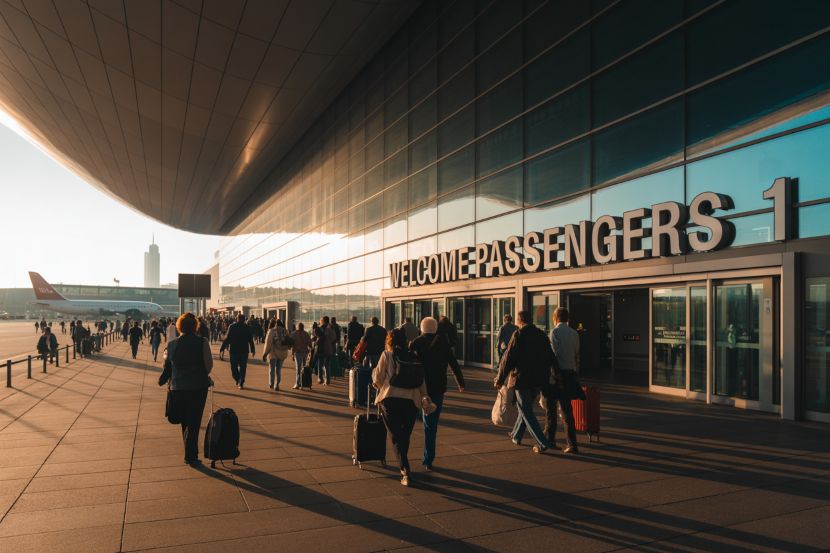
Home » Airlines News of Germany » Frankfurt’s Terminal 3 Set to Open in April 2026, Enhancing Germany’s Key Aviation Hub with Upgraded Capacity for Schengen and Non-Schengen Flights – What It Means for Air Passengers
Published on October 14, 2025
Frankfurt Airport, one of Europe’s busiest and most important travel hubs, is set to open its highly anticipated Terminal 3 in April 2026. This new addition is expected to significantly boost the airport’s capacity, allowing it to better serve millions of passengers annually. After nearly a decade of planning, design, and construction, Terminal 3 will be ready to welcome travelers to a state-of-the-art facility. The terminal will not only improve the airport’s efficiency but also enhance the overall passenger experience.
A Decade-Long Journey to Completion
The project, which began in 2016, faced several hurdles during its development, including global supply chain disruptions and the unforeseen challenges brought by the COVID-19 pandemic and geopolitical tensions. Despite these setbacks, Frankfurt Airport maintained its schedule and completed the terminal on time and within budget. Terminal 3 will initially serve airlines that were previously operating out of Terminal 2, with a phased move-in set to begin in mid-April and conclude by June 2026.
Advertisement
The terminal’s completion marks the culmination of years of construction work, a journey that involved meticulous planning to meet aviation standards and passenger needs. All regulatory approvals have been obtained, including essential fire safety inspections, ensuring that the terminal will meet the highest standards upon its opening.
What to Expect from Frankfurt’s New Terminal
Once open, Terminal 3 will handle up to 19 million passengers each year. The terminal will consist of three main sections: Piers G, H, and J, which are designed to accommodate both Schengen and non-Schengen flights. This dual capability is crucial, as it ensures that Frankfurt can efficiently handle passengers traveling across Europe and long-haul international destinations. The integration of these two travel categories will streamline the movement of people and reduce congestion during peak times.
Advertisement
The final phase of construction focuses on essential details like installing advanced security systems, finalizing the commercial areas, and ensuring that the baggage handling system operates smoothly. Before opening to the public, a series of extensive tests will take place. The testing phase will involve 8,000 volunteer passengers, simulating real-life scenarios to make sure that every system functions as expected. This phase is set to begin in early 2026 and will run for a period of 21 days, giving the airport ample time to address any last-minute issues.
Why the New Terminal Matters for Travelers
For passengers, the opening of Terminal 3 means a more spacious, modern, and comfortable environment in which to travel. The terminal will offer state-of-the-art facilities, including a wide range of retail shops, restaurants, lounges, and other amenities. These features will cater to both leisure and business travelers, providing options for shopping, dining, and relaxation before flights.
Advertisement
In addition to these upgrades, the new terminal will improve the overall airport flow, reducing the stress associated with air travel. The larger passenger handling capacity and more streamlined processes will make it easier for travelers to navigate the airport and access services quickly, whether they are departing or arriving.
What Should Travelers Expect When Terminal 3 Opens?
Travelers flying through Frankfurt Airport in 2026 can expect smoother check-ins, faster baggage claim processes, and a more pleasant airport experience overall. While the airport’s existing terminals continue to operate, Terminal 3 will serve as a fresh space, designed with modern amenities and innovations that reflect the needs of today’s travelers.
However, it’s worth noting that the transition into the new terminal will happen gradually. Passengers flying with airlines that are scheduled to move to Terminal 3 will be notified well in advance, ensuring a smooth transition and preventing confusion on the day of travel. Given the scale of the project, it’s crucial for travelers to keep an eye on updates from Frankfurt Airport and airlines, as timelines for the full move may vary.
Enhancements for Future Expansion
One of the most exciting aspects of Terminal 3 is its scalability. While the terminal will initially handle 19 million passengers annually, it is designed with future growth in mind. There is potential to expand the terminal further, increasing its capacity to meet growing demand as more people travel through Frankfurt Airport in the coming years. This flexibility is key to ensuring that the airport can keep up with rising passenger numbers and the ever-evolving demands of the global aviation industry.
With airlines already eager to settle into the new terminal, Frankfurt Airport is positioning itself as a leading gateway to Europe and beyond. This expansion is part of a larger effort to ensure that the airport remains competitive in an increasingly connected world, where travelers demand high-quality services and seamless travel experiences.
In Closing
The completion of Terminal 3 represents not only a significant achievement for Frankfurt Airport but also a major milestone for Germany’s aviation infrastructure. As air travel continues to rebound and grow post-pandemic, this new terminal will play a critical role in accommodating the increasing number of travelers. The opening in April 2026 promises a new era for Frankfurt, ensuring that it remains one of the most vital and modern hubs in Europe for years to come.
Advertisement
Please visit:
Our Sponsor
